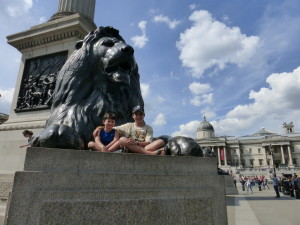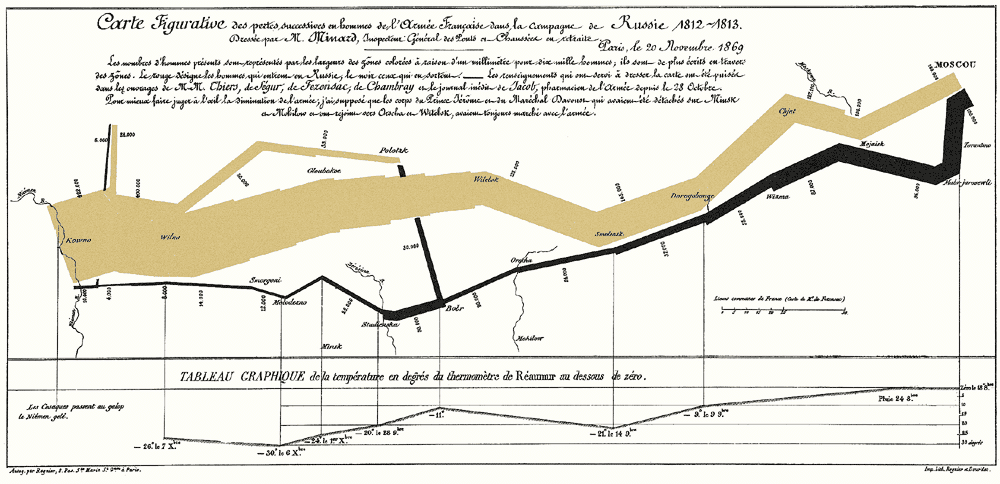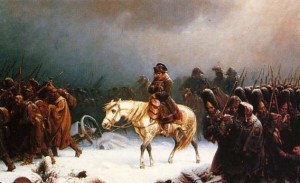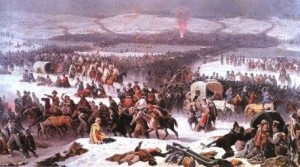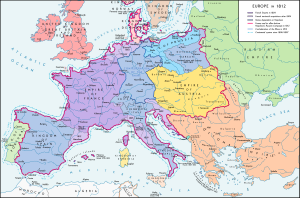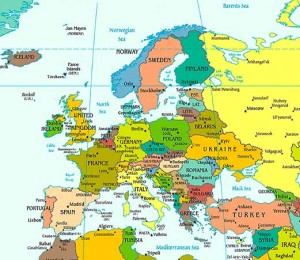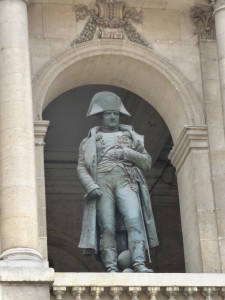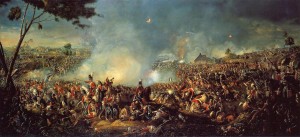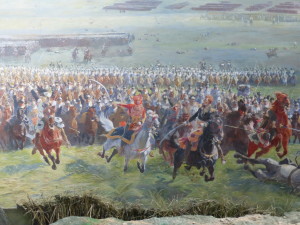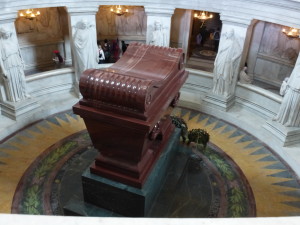Napoleon Bonaparte was a fascinating ruler and military strategist. He was born in 1769. He lived until 1821, where he died in exile on an island in the middle of the Atlantic Ocean.
Napoleon’s Rise to Power
The French Revolution had finished. It had been a long and bloody battle, with many deaths. In 1794, the directors came to power. Many royalists and Louis the XVI were executed by “humane ways,” (namely with the head-chopping machine called the guillotine) and then the republic was formed. There were five directors in the counsel.
In 1795, people started getting frustrated. Their director counsel had not changed the fact that people were still going hungry and the wealth of France had not increased. That had been the original reason for becoming a republic and executing the king. Many people even thought that with a king and queen, they had had more money! As a result, many people became royalists, and the royalists attacked the government building and it even looked seriously problematic for the directors, because the royalists had better numbers. Luckily for the directors, they had a young, very ambitious artillery captain on their side, a man named Napoleon who would change the course of history.
Napoleon Bonaparte had witnessed the siege of the Tuileries (when the revolutionaries stormed the government and imprisoned Louis the XVI), and he reflected that if the royalists had possessed better artillery, they would have won. So, he prepared the grapeshot cannons. A grapeshot cannon is a cannon where they fill the barrel with pellets that are clustered together so they resemble a bundle of grapes. You can imagine these allowed him to mow down the enemy with ease.
The directors saw the obvious ambition he had, and so sent him far from the seats of power. They gave him the rank of Commander-in-Chief of the Austrian-occupied Italian front, where they were at war with Austria. France wanted to help people in other countries overthrow monarchies. The resisters in the First Coalition were Prussia, Austria, and Great Britain. Great Britain attacked the North-west front on the ocean and the Prussians and Austrians attacked eastern France. In 1796, he was hugely successful in the Italian campaign, and he made much ground. Later, Austria saw the damage and made a very temporary peace with France in late 1797, ending the First Coalition.
In 1798, Napoleon went to Egypt, and took over the country. Some people think that he went to Egypt to eventually capture British India. Others think that he might just have wanted to take over Egypt because it was a formerly great empire. Either way, he was again very triumphant. But there was a little problem. The 20,000 troop army had gone to Egypt, obviously by ship. After they landed, the British trapped them in with their dominant navy force, led by Horatio Nelson, because they were at war with the French. He sank all their ships in the battle of the Nile and stranded the Napoleon and his army in Egypt. So, in 1799, Napoleon wreaked havoc in Damascus and Syria. But they were still trapped in the Middle-East. Napoleon, as ambitious as he was, wanted to get back to France. So later, Napoleon abandoned all his 20,000 troops at the hands of the Ottoman Empire and snuck back to France.
When he arrived back in France, he saw that the directory has grown even more unpopular because the people were still poor. So three of the directors schemed with him to seize more power, as he was hugely popular. They resigned and encouraged the legislature to go to an estate west of Paris where they would be protected by Napoleon. When they arrived, Napoleon made a long speech about them not doing enough to help the people, the state, the army, etc. They didn’t like that, so they just jostled him out of the room. After he has been kicked out, his brother told him how those legislators were becoming violent and Napoleon needed to go in the building and take order. So Napoleon’s guards went in and dissolved the legislature. That allowed two of the plotting directors and him to seize power and become the “Three Consuls of France.” Soon after, Napoleon was able to scheme his way into being called the “First Consul.” That really marked the beginning of Napoleon’s rule.
Napoleon’s Rule
The Second Coalition started in 1798, and the main opposing forces were Austria, Russia, and Great Britain. Napoleon fought against this coalition by attacking Austria-controlled Italy, and was again successful. The Austrians and Napoleon established another treaty in 1801. The next year, he designed a treaty with Britain. Later that year, newspapers proclaimed Napoleon “First Counsel for Life.” In Haiti, France’s most profitable slave center, the slaves revolted, and the slaves were later freed. That lost France a lot of much needed money.
In the beginning of 1803, Napoleon realized that Great Britain controlled the seas and he gave up on controlling any of North America. As a result, he remembered that France owned Louisiana and thought, “If I don’t sell Louisiana, either Great Britain or the United States will take it from me. And, if I sell it, I will get the much needed money.” So he sold it.
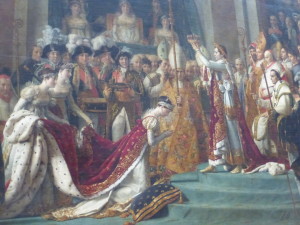
Fast Fact: Napoleon declared himself emperor in 1804. The big difference between First Consul and Emperor is that it assumes his descendants will also have the title of Emperor.
In 1803, Britain started forming a coalition and by 1805, Austria, and Russia joined. Then the British navy, led by Horatio Nelson, went to where the French navy was, off the coast of Trafalgar, a cape in Spain. There they destroyed the French navy, the only navy that could compete with them on any level. This firmly gave the British (and every other country) the knowledge that the British navy ruled the seas.
The next big turning point was when Napoleon’s army destroyed the Austrians at Ulm. They did this by distracting them with the appearance of a major army coming from one way and then going around to attack them from behind with the Wheeling maneuver. Then later the Russian forces and the Austrians regrouped and met the French again in Austerlitz. They were able to massacre the Austrians’ and Russians’ forces once again. After that, France emerged dominant and gained much territory from the Austrians.
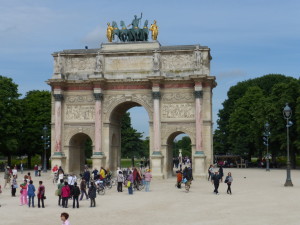
We also visited the Arc de Triomphe in Paris, which was commissioned by Napoleon to celebrate his victory at Austerlitz.
In 1806, the king of Prussia got paranoid about Napoleon attacking and waged war. Later, Great Britain and Russia also joined to make the Fourth Coalition. Soon after the war started, Prussia got trounced at Jena and Auersted, two cities in what is now Germany. The Russian forces then arrived and were chased through what is now Poland. Then in Eylau there was a bloody, long stalemate with Russia in 1807. France won the battle, but barely. Napoleon decisively met them again at Friedland and finished the Fourth Coalition. A month later, France signed the treaties of Tilsit. He signed an impolite, I’m-more-powerful-than-you treaty with Prussia and a polite treaty with Russia, saying we are allies. The Prussia treaty also declared that half of Prussia would become France’s satellite countries and made his brother king of one half and his other brother king of the other half.
He also realized that he had a good amount of Europe under his control, and so he established the Continental System, which said pretty much, “If you are France, my ally, or my satellite country, you will stop trading with Britain, and then Britain will have a problem.” The Russian treaty said “Russia will enter the Continental System, in exchange for being able to do whatever it wants with the Ottoman Empire.” Before this, Napoleon had promised he would defend the Ottoman Empire if Russia attacked them. That made the Russians accept the treaty.
Napoleon’s Fall
After all this, Napoleon was feeling pretty good about himself. After all, he had conquered most of Europe. But he realized that Portugal still did a lot of trading with Great Britain. So he said to the king of Spain, “If we team up, we can defeat Portugal.” The Spanish king thought, “Well, if we destroy Portugal, I will get all its territory in other lands as well as completing the peninsula.” So he accepted and France poured troops into Spain. Soon they were all over and they had the excuse of being in Spain to destroy Portugal. They did destroy Portugal in late 1807, but after, in 1808, they kicked out the king of Spain and Napoleon’s other brother took over. Napoleon headed back to Paris, certain of his brother’s control.
Fast Fact: Remember, before this, Spain and Portugal have all that other territory in South America. While they are engaged with Napoleon, many of those Latin American countries think, “Why do we have to listen to them? We don’t even know who is in charge there.” This was a big reason for the eventual revolt of those countries.
The Spanish naturally didn’t like that, and they realized that if they attacked with a full-on battle, they would lose. In 1808, they tried the tactic called guerilla warfare, where little groups attack the soldiers when they don’t expect it, then run away before they can retaliate. This weakened the French so much that they had to retreat, and Napoleon thought, “If you want something done well, do it yourself.” And so he went down to Spain at the end of 1808 and temporarily stopped it. The Spanish kept fighting though, and continued to weaken the French troops. This kept draining his supplies slowly but surely.
Before Napoleon came down to Spain, another uprising occurred in Portugal, which the British saw as their chance to push France out. So Sir Arthur Wellesley and his fleet traveled to Portugal to challenge France’s control. This was another reason for Napoleon to come back down to the Iberian Peninsula (the peninsula that Spain and Portugal are on).
Napoleon also saw that the Papal States were not participating in the Continental System. So he went down into Italy and overpowered the Papal States, which became a part of France. Pope Pius VII, the pope in charge in the Papal States, excommunicated Napoleon, and so the pope was abducted by the French. It’s not certain that Napoleon ever gave the order to abduct him, but he never ordered his release, either, so it must have been okay with him. The Fifth Coalition, which included Austria and Great Britain, started in 1809 and ended pretty quickly. By the end, Austria had to give up a quarter of its land to one of his brother’s kingdoms. As you can imagine, that just made Austria all the madder.
In 1811, Russia started to relax the Continental System, which infuriated Napoleon, because he thought he was being nice to them. After all, they lost in the Fourth Coalition and he allowed them to attack the Ottoman Empire in exchange for entering the Continental System. The next year, Napoleon heard that Russia was considering invading the Duchy of Warsaw. Napoleon got very mad when he heard about this. He then decided that they weren’t friends anymore and invaded Russia in April of 1812. Here is a chart of his invasion. This is one of the most famous charts in the world and many people think it’s the best. It was made Charles Joseph Minard.
See how thick it is at the beginning? The thickness of the line signifies the amount of troops they had. At the beginning, Napoleon had 422,000 men. The chart’s curves and rivers were the turns and rivers they had to cross. The bottom chart is the temperatures during the retreat. It’s on the Reaumur scale, but if multiplied by 1.25 you get Fahrenheit. The shrinking of the line occurred as they traveled into enemy territory, because Napoleon had to leave soldiers behind to guard the supply routes and some were lost in skirmishes. The only minor battle was at Smolensk. The French won, but it was not a decisive battle. The Russians only retreated and the French continued to move toward Moscow. It was getting into fall now, and it was getting cold. But you might think that there were grain and starches for the advancing army to plunder along the way. The Russians noticed the disadvantage they had, and so they burned the fields as they retreated towards Moscow. Then, in 1812, the French finally engaged the Russians at Borodino, a city right outside of Moscow. At that point, Napoleon had 135,000 troops. They engaged the Russian army in a super bloody battle. The battle ended with the estimated casualties numbering 44,000 on the Russian side and 35,000 on the French side. The French won barely, and progressed to Moscow. Napoleon was expecting that they would just hand over the title of emperor to him and then his troops would eat all the food that should be available. So a week later Napoleon walked into Moscow and found it deserted, empty of food, and soon it began to burn! Napoleon recognized defeat and retreated away from Moscow, worried about the coming winter.
He walked away from Moscow with 100,000 troops, and if you go back up to the chart, you can see that at the end of the retreat, he only had 10,000 of those troops. Here are some pictures of his retreat:
Napoleon at the end lost 300,000 men, 200,000 horses, and thousands of cannons, and the other countries smelled blood. So Britain, Prussia, Austria, Russia, Sweden, Spain, and Portugal teamed up in the Sixth Coalition, to try and defeat him once and for all. After all, he controlled a whole lot of Europe. This is a map of Europe when the French empire was at its greatest extent.
This is a map of Europe nowadays.
So when the Sixth Coalition started, Napoleon quickly raised 400,000 troops, which is a number that might be able to withstand another coalition. But this coalition was much stronger than the previous ones. The opposing forces were 1,000,000 men strong. Although he was outnumbered, Napoleon won many of the first battles in 1813. So the opposing forces issued the Trachenberg plan, which basically said how their military should try not to engage Napoleon’s army. They did that because Napoleon was a very smart strategist and if they fought the other generals, they would more likely win. And then, in autumn of 1813, Napoleon lost his first very influential battle, and he had to give up control of the Confederation of the Rhine. He then went back to France as the opposing forces started to attack the French Empire itself. Meanwhile, when all this went on, Arthur Wellesley, the British leader of the rebel Spanish and Portuguese forces, had succeeded in pushing the French army out of Spain and now was continuing to push into France. But Napoleon, as a last line of defense, engaged the allied military in North-East France, starting the Six Day Campaign in early 1814. He was able to keep his line for four battles, but at some point his forces just got overwhelmed by the 2:1 ratio against them. In March, 1814, the coalition marched into Paris. But Napoleon didn’t want to give up, and so he said to his generals, “Let’s go retake Paris!” Fortunately his generals had given up and they and the soldiers refused to follow him, because if they had, more people would have died and the result would still be the same. In April of 1814, Napoleon was forced to resign. He was moved to the island of Elba, a little tropical island off the coast of Italy. He was even given control of the island, because all the royalty at that time were afraid to punish him too severely, in case that punishment came rolling around to them. So then Louis the XVIII, the brother of the executed king, was restored to the crown. Louis the XVII never got a chance to become king because he died in prison when he was just a boy.
Ten months later, Napoleon was able to come back to the southern shores of France. He came back because he thought he was in danger from assassination, he wanted to be back with his family, and he wanted to rule France again. The French authorities figured out that he had returned and notified the king, who sent an army to go and kill him. When Napoleon saw the army, he walked up to them, completely weaponless, and said, “Go ahead. Shoot your emperor.” And soon, they placed him in charge of their army and he took control. They did that because everyone in France still really considered him their emperor. He stated the golden age of France and he was greatly respected for that. Then he and his army started walking to Paris. When Louis the XVIII, the brave man that he was, found out about this, he ran away. By the beginning of spring, 1815, Napoleon was back on the throne. Before that, the rest of Europe got word of his return and decided to attack. But Napoleon, knowing that they needed time to reorganize, attacked before they could. He assaulted the combined forces of Prussia and Great Britain in what is nowadays Belgium. There he encountered many battles; the biggest was the battle of Waterloo.
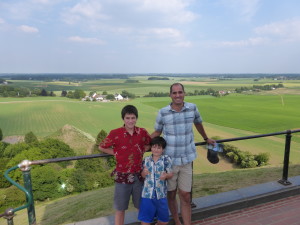
On the Lion’s Mound, looking over the field where the battle of Waterloo took place in Belgium. 300,000 men and 7 countries fought in this battle.
After that, Napoleon noticed that if he didn’t surrender, the Prussians might do something really nasty to him. And so he surrendered himself to the British and was exiled to the island of St. Helena, which is in the middle of the Atlantic Ocean. Napoleon’s reign was ended for good. Six years later, he died from stomach cancer.
Napoleon was a fascinating military genius, and he is still a popular figure today. His influence can still be seen in France, Elba Island, and his conquered territory. He will not be forgotten for a long time yet.
